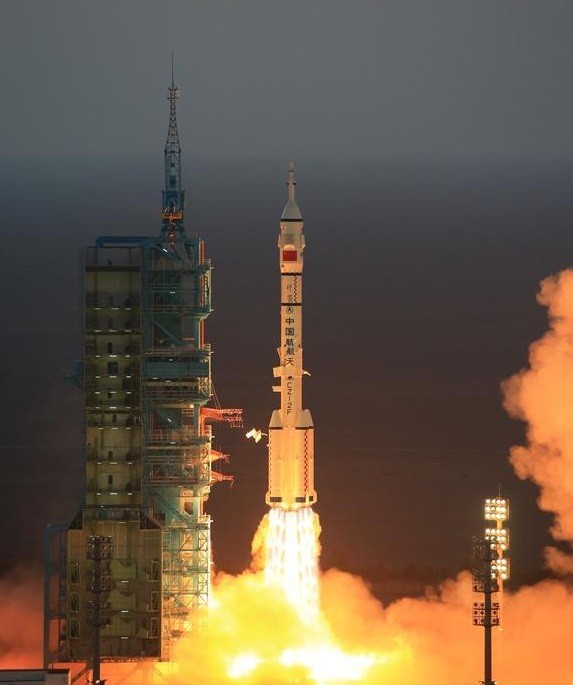By Ana Verayo, | October 17, 2016

The Shenzhou-11 spacecraft is launched on top of a Long March booster rocket in China's Gobi Desert on Sunday.
Two Chinese astronauts blasted off into lower Earth orbit on Sunday, October 16 onboard a Long March rocket towards the Tiangong 2 "Heavenly Palace" space module. The two astronauts are on a month-long mission to build China's second space station.
At around 7:30 p.m. EDT, the Long March booster rocket launched from the Jiuquan Satellite Launch Center in China's Gobi Desert. The "taikonauts" are heading to the space module located 240 miles above the surface of the planet.
Like Us on Facebook
The two Chinese astronauts--mission commander Jing Haipeng and flight engineer Chen Dong--are en route to the space lab via the Shenzhou-11 spacecraft.
After nine minutes into the launch, the spacecraft separated from the booster rocket. The crew is set to arrive at the space station, docking on Tuesday, October 18.
According to China's space program chief commander, Zhang Youxia, the rocket was launched and flew according to its original plan. The Shenzhou spacecraft has entered into preliminary orbit. The spacecraft's solar panels have been launched, and the crew is in great condition.
Similar to the International Space Station, the Tiangong-2 is China's second space station module that has better life support systems, communications, and research equipment, along with an improved habitat for crew members.
As part of their mission, the two Chinese scientists will now carry out multiple experiments to test the module's critical systems to construct and finish a larger multi-module space station within this decade.
This space mission will involve a lot of scientifical experiments and medical research about plant biology and testing repair methods while in orbit in a microgravity environment.
After a month, Jing and Chen will undock and return via the Shenzhou spacecraft's descent module, landing with parachutes in Inner Mongolia.
This mission is the beginning of a series of crucial processes required for China to assemble a fully operational space station similar to Russia's Mir space station, which will be bigger than the nearly-retired ISS.
China is the third nation after the United States and Russia to launch a manned spacecraft into lower Earth orbit.
-
Use of Coronavirus Pandemic Drones Raises Privacy Concerns: Drones Spread Fear, Local Officials Say

-
Coronavirus Hampers The Delivery Of Lockheed Martin F-35 Stealth Fighters For 2020

-
Instagram Speeds Up Plans to Add Account Memorialization Feature Due to COVID-19 Deaths

-
NASA: Perseverance Plans to Bring 'Mars Rock' to Earth in 2031

-
600 Dead And 3,000 In The Hospital as Iranians Believed Drinking High-Concentrations of Alcohol Can Cure The Coronavirus

-
600 Dead And 3,000 In The Hospital as Iranians Believed Drinking High-Concentrations of Alcohol Can Cure The Coronavirus

-
COVID-19: Doctors, Nurses Use Virtual Reality to Learn New Skills in Treating Coronavirus Patients







